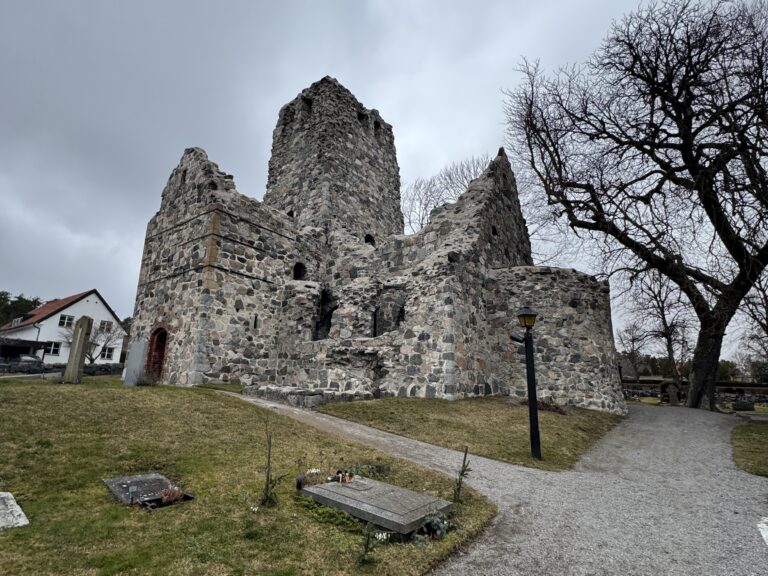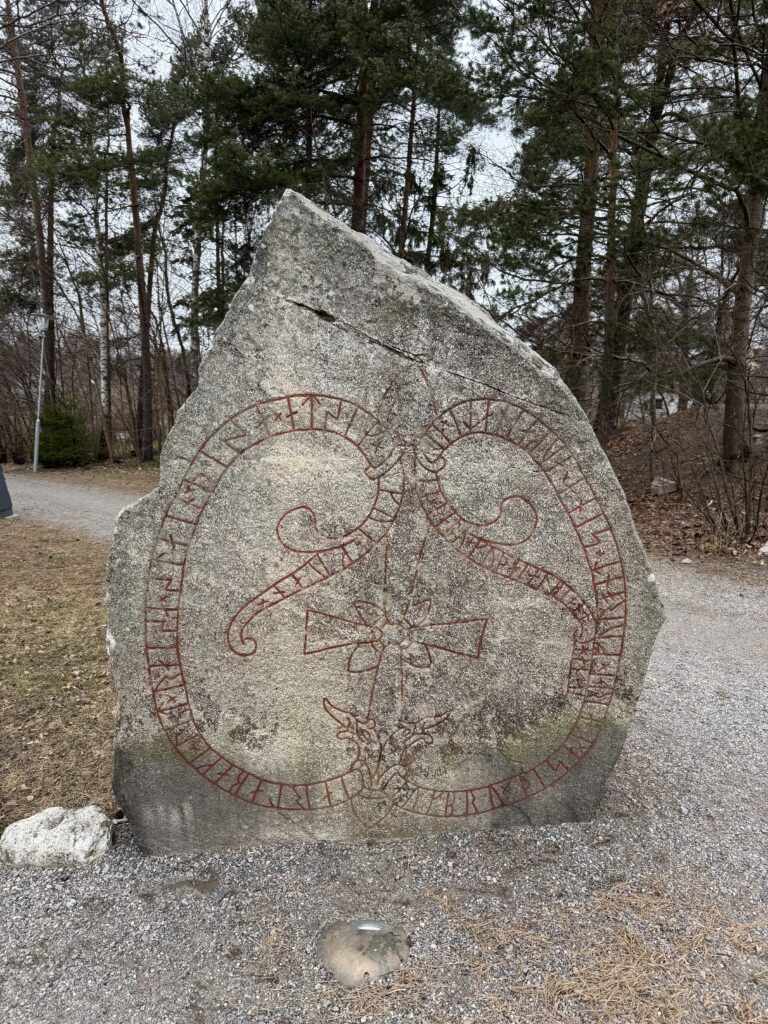Just outside the city of Uppsala – about an hour north of Stockholm – lies a small village with an extraordinary past. Gamla Uppsala (meaning “Old Uppsala”) might seem unassuming at first, but walk a little further and you’ll spot three massive grassy mounds rising from the earth. These are the Royal Burial Mounds, mysterious earthworks that have fascinated people for centuries. According to folklore, the three great mounds are the resting places of Norse gods Thor, Odin, and Freyr! Others later believed they held the tombs of ancient Swedish kings of the legendary Yngling dynasty. Standing there, with the wind sweeping over the plains, it’s easy to feel like you’ve stepped into a scene from a Viking saga. In this post, we’ll explore the rich history behind Gamla Uppsala’s mounds, share travel tips for visiting, and dive into the mystical atmosphere that makes this place so special.
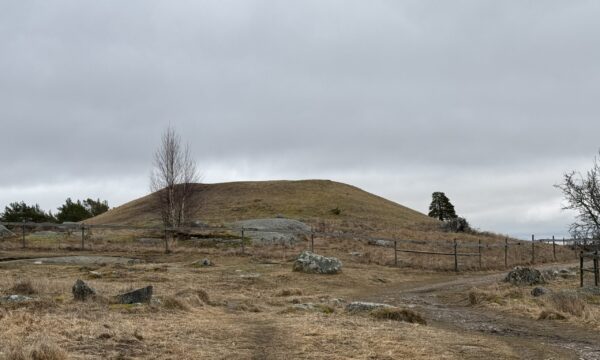
Legends of Gods and Ancient Kings
Gamla Uppsala was a power center of Iron Age Scandinavia, and it accumulated many legends. In Norse mythology and local folklore, people truly believed these enormous mounds were something more than just tombs. One medieval writer claimed the mounds were the graves of the gods themselves – Thor, Odin, and Freyr – essentially making Gamla Uppsala a burial ground of deities. Later on, scholars linked the mounds to three early kings from the House of Yngling (a semi-legendary dynasty), even nicknaming them Aun’s Mound, Adils’ Mound, and Egil’s Mound after those rulers.
So, what’s really inside these giant hills? In the 5th and 6th centuries AD – long before the Viking Age – this spot was chosen as a royal burial site. The mounds were constructed atop a ridge on purpose, making them even more imposing against the skyline. When a king or chieftain died, his body was cremated in a great pyre along with his belongings (weapons, jewelry, even perhaps horses), and the ashes were buried under a pile of stones, gravel, and earth to form a mound. According to Norse belief, the funeral fire would send the fallen leader to Valhalla – Odin’s hall of heroes – along with all the riches burned on the pyre. As one old saga explains, “for men of consequence a mound should be raised to their memory… it was their faith that the higher the smoke rose in the air, the higher he would be raised whose pile it was”. In other words, the bigger the mound, the greater the man (and his chances of impressing the gods)!
By the time of the Viking Age, these three royal mounds at Uppsala were already ancient, but they loomed large in cultural memory. The site was so famous that it’s even referenced in the Old English epic Beowulf and other legends. Archaeologist John Ljungkvist remarks that the kings of this era “transformed the entire landscape to showcase what they thought was their divine lineage… It’s Beowulf, for real.”. Indeed, Gamla Uppsala became a central gathering place for nearly a millennium, where myth and power went hand in hand.
However, not everyone in history believed the myths. In the 19th century, some skeptics dared to suggest these hills were just natural formations – mere “lumps of dirt” – which offended Swedish national pride. To settle the matter, King Karl XV (then Crown Prince) ordered a high-profile archaeological excavation in 1846. Bror Emil Hildebrand, the lead archaeologist, dug into the Eastern Mound (once dubbed “Odin’s Mound”) and proved it was indeed a man-made tomb. Inside, they found a clay urn with burned human bones and charred grave goods – not exactly golden treasure, but undeniable evidence of a burial. The remains in this mound likely belonged to a cremated woman and a young boy, given the analysis of the bones.
A few decades later, in 1874, archaeologists tackled the Western Mound. This time the findings were more spectacular: they uncovered the cremated remains of a distinguished man (a probable warrior-king) along with his war gear and luxurious weapons. They even found ivory game pieces and Roman cameos buried with him, suggesting that the people of Gamla Uppsala had far-reaching trade connections – possibly as far as the Mediterranean world! The central Middle Mound (the second mound) has not been fully excavated to this day, so it still holds some secrets. But archaeologists are quite certain that all three mounds were elite royal burials – essentially a family cemetery for a ruling dynasty. The myth about gods being buried here was likely a way for later storytellers to honor (or exaggerate) the importance of these kings. In any case, the Royal Mounds of Gamla Uppsala are among the oldest and most important burial monuments in Sweden, so iconic that they feature on book covers about Swedish national identity.
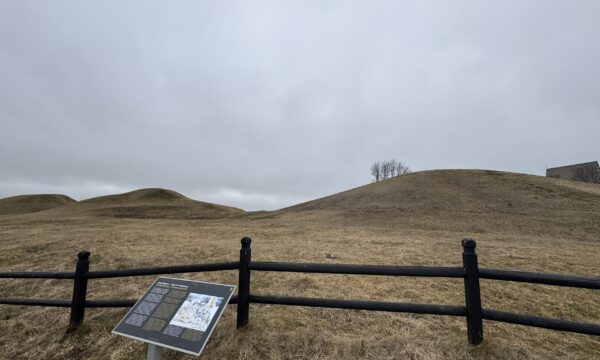
A Sacred Landscape of Norse Faith
Besides the royal tombs, Gamla Uppsala was revered as a holy site in Norse pagan religion. It wasn’t just a cemetery; it was basically the religious capital of the Svea (Swedish) tribe in pre-Christian times. Imagine this area bustling with activity during grand seasonal festivals: sacrifices, feasts, and gatherings of chiefs and common folk. Historical sources describe a magnificent Temple at Uppsala that once stood here, dedicated to the gods Thor, Odin, and Freyr. This temple was said to be adorned with a massive golden chain draped around its roof and housed wooden statues of the three gods inside. Just outside was a sacred grove of trees and a holy spring or well.
Medieval chronicler Adam of Bremen, writing in the 1070s, gave a famously dramatic account of the pagan rituals at Uppsala. He claimed that every nine years a great festival called Dísablót or Fröblot was held at the site during the winter solstice. People from all over Sweden and beyond would gather, and over the course of nine days, nine males of every living species were sacrificed to the gods – including nine human men. The victims were hung from the branches of the sacred trees in the grove, and every tree was considered holy because it was touched by these offerings. Adam even mentions a large tree near the temple that stayed green all year round, which no one dared cut, and a sacrificial well where a live person would be thrown – if they disappeared in the water, it was taken as a favorable omen from the gods. These descriptions are hair-raising (and scholars debate how much is exaggerated), but there’s no doubt that Gamla Uppsala was the major pagan cult center of Sweden before Christianity. It was a place where religion, myth, and political power were deeply intertwined.
By the late 11th century, however, Christianity had spread in Sweden, and the old pagan ways were under assault. Around 1087 AD, King Inge the Elder (Ingi) reportedly destroyed the temple at Uppsala after a showdown with pagans who wanted to continue the sacrifices. A church was built on the site soon after – literally on top of the pagan temple’s ruins – as a symbolic replacement. In fact, Gamla Uppsala became the seat of Sweden’s first archbishopric in 1164, cementing its place in the new Christian order. The small Gamla Uppsala Church that stands there today dates to the 12th century (with later alterations) and is believed to incorporate some of the timbers or location of that original cathedral. Stepping into this stone church, you can still see faded medieval frescoes on the walls and even the grave of the famous scientist Anders Celsius (inventor of the temperature scale) tucked in the floor! On the outside wall, there’s an ancient 11th-century runestone embedded in the church masonry, and a couple more rune stones nearby, blending Viking-age writing with the Christian setting. It’s a powerful illustration of how old and new religions meet at Gamla Uppsala – quite literally layered on top of each other.
Gamla Uppsala was not only about religion; it was also a political hub. This was the site of the Thing of All Swedes, a general assembly where people would gather to make laws and decide important matters in the Viking Age. One of the smaller mounds in the area is still called the Tingshögen (Thing Mound), thought to be the podium where the kings addressed the crowd. Imagine the royal proclamations echoing over the plains, perhaps with the three big burial mounds standing as solemn witnesses in the background.
The entire landscape of Gamla Uppsala is considered a sacred landscape. Archaeologists have found traces of large wooden halls and buildings near the mounds – likely royal feasting halls or cult houses where nobles gathered. There are also remains of hundreds of smaller graves surrounding the big mounds. In fact, originally there may have been as many as 2,000 to 3,000 burial mounds of various sizes here! Many have been worn down or removed by farming over the centuries, but about 250 smaller barrows still survive in the fields around Gamla Uppsala. This was truly a “city of the dead” and holy ground for ancient Swedes – every hillock could be a burial, and every inch of soil potentially held offerings to the gods. No wonder the place still feels hallowed.
Fast forward to more recent times, Gamla Uppsala’s mystique endures. It even attracted Pope John Paul II, who held an open-air Mass by the mounds in 1989 – a powerful gesture of reconciliation between Sweden’s pagan past and Christian present. And in the year 2000, something remarkable happened: Swedish practitioners of Ásatrú (the modern Norse pagan faith) restarted the tradition of holding blóts (ceremonial offerings) at Gamla Uppsala. These modern ceremonies are of course peaceful and symbolic (no human sacrifices), but it’s fascinating to think of modern pagans gathering quietly by the ancient mounds to honor the Old Gods once again. Gamla Uppsala truly remains a sacred site, in every sense of the word.
Mystical Impressions: Walking Among Ancient Giants
Visiting Gamla Uppsala is not just a history lesson – it can also feel like a spiritual or mystical experience, even if you’re not religious. As you walk along the designated paths, the three great mounds dominate the scenery. Each mound is about 30 meters across and around 10 meters high (roughly 32 feet), which might not sound huge, but when you’re standing next to them, they really do feel like giants. You might find yourself instinctively lowering your voice, as if you’ve entered an open-air temple (which, in a way, you have!). The atmosphere here is often described as peaceful yet awe-inspiring. There’s usually a gentle breeze, and you can hear birds chirping and the rustle of grass – it’s mostly quiet, since Gamla Uppsala is just a small village with no city noise.
Take your time strolling around the mounds. There is a wooden boardwalk and gravel trails that let you get up close without disturbing the site. If you visit in the early morning, you might catch a bit of mist lingering around the hills, giving the whole scene an ethereal feel as if the spirits of the ancients are waking up. In the late afternoon or evening, especially in summer, the sun casts amazing long shadows and a warm light over the mounds. The play of light and shadow can make the landscape look positively otherworldly. Many visitors (and locals) love to come here around sunset for this reason – the sky often turns vivid orange and pink behind the silhouettes of the mounds, a perfect moment to reflect and perhaps imagine the ghostly echo of ancient rituals on the breeze.
If you’re a fan of Norse mythology, you might find yourself daydreaming about Odin or Freyr as you gaze at the mounds. It’s not hard to picture a grand procession of pagans in the field, or priests leading a horse up the mound for sacrifice, or perhaps skalds (poets) telling stories of heroes by a bonfire. The site has a way of firing up the imagination. Some people describe feeling a strong “energy” here – whether that’s due to the deep history or just the tranquility is up to you to decide. It’s the kind of place where you might want to sit on a bench for a while, soak it all in, and maybe even meditate a bit on the passage of time. After all, over 1,500 years ago real people stood on this very ground mourning their lost kings and making offerings to their gods. That realization tends to give you goosebumps.
Even during modern festivities, the magic of Gamla Uppsala shines through. In summertime, the locals sometimes use the area for traditional celebrations. For example, at Midsummer (late June), an age-old Swedish holiday, people gather near Gamla Uppsala to dance around the maypole, play folk music, and celebrate the longest day of the year – all within sight of the ancient mounds. It’s a beautiful blend of living tradition and ancient backdrop, and one could argue the fertility rites of Midsummer have distant echoes of the pagan past. In August, there’s often a Viking-themed event or historic market where reenactors set up a camp near the mounds. You might stumble upon folks in Viking garb demonstrating iron forging, weaving, or sword-fighting demonstrations, which really brings the past to life in an interactive way. During these events, Gamla Uppsala transforms into a buzzing Viking village again, if only for a weekend – an experience that’s both fun and surreal, given the setting.
Whether you visit on a quiet day or during a festive event, try to be present and open to the atmosphere. Gamla Uppsala can be many things: a window into the Iron Age, a sanctuary of Norse gods, a burial ground of kings, and a simple pastoral vista. It’s historical and mystical all at once. Some travelers say they felt a connection to their ancestors here; others just enjoy the fresh air and scenery. As you walk among these grassy giants, you might feel a sense of continuity – the idea that life, death, and worship have all played out on this stage in an unbroken chain from prehistoric times to today. It’s a humbling and inspiring thought.
(Pro tip: Bring a notebook or sketchpad if you like to write, draw, or journal. There’s something about Gamla Uppsala that might unleash your creative side! And definitely bring a camera – more on that below.)
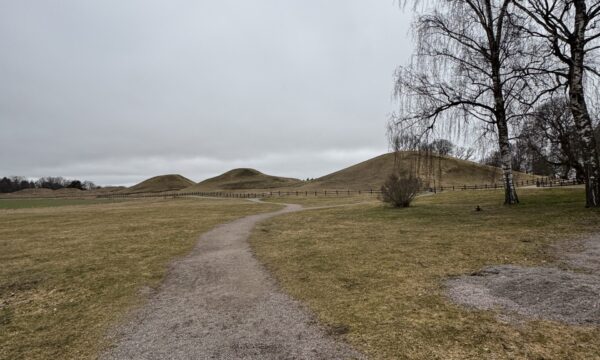
Visiting Gamla Uppsala: Travel Tips and Highlights
Ready to plan your trip? Despite its immense historical importance, Gamla Uppsala is very easy to visit and makes a great half-day or full-day trip from Stockholm or Uppsala. Here are some handy travel tips to make the most of your visit:
-
Getting There: Gamla Uppsala is located about 5 kilometers (3 miles) north of Uppsala city center. If you’re coming from Stockholm, first take a train (35–40 minutes) to Uppsala. From Uppsala Central Station, you have a few options: bus #2 or #110/115 (check current route numbers) will take you towards Gamla Uppsala – just hop off at the “Gamla Uppsala” stop near the church. The bus ride is only 10-15 minutes. Alternatively, if the weather’s nice, you can walk or rent a bike and follow the clearly marked path north to Gamla Uppsala; it’s a flat and pleasant route through suburbs and fields, taking around 30–45 minutes on foot. By car, it’s an easy drive and there is parking by the Gamla Uppsala museum.
-
When to Go: The site is open year-round, 24/7 (it’s essentially an open nature area). There’s no entrance fee to walk around the mounds. Each season has its charm: in summer, the grass is green and you have long daylight hours (plus guided tours and events available); in winter, the mounds might be snow-covered – very picturesque, though bundle up! If you go in spring or autumn you might catch morning fog or fewer crowds. Sunset hours on a clear day are highly recommended for that golden light. Also, if you’re interested in local culture, consider timing your visit to coincide with events like the Historical Days Viking festival in summer or the Midsummer celebration at the nearby open-air museum Disagården. Even Sweden’s National Day (June 6) is celebrated at Gamla Uppsala with folk music and flag-raising at Disagården. These events can add a whole extra layer of experience (check Uppsala’s event calendar for dates).
-
Old Uppsala Museum: Adjacent to the mounds (you’ll see a modern wooden building near the parking area) is the Gamla Uppsala Museum. It’s absolutely worth a stop if you’re keen on history. Inside, you’ll find artifacts excavated from the mounds and surrounding area, like jewelry, weapons, and even small fragments of those gold-embroidered textiles. The museum does a great job explaining the Vendel era and Viking era history of the site, with 3D models, interactive displays, and a timeline that puts everything in context. One highlight is a scale model of Gamla Uppsala as it may have looked around the year 600 – complete with the great hall, the temple, and lots of tiny figures. It really helps you picture the bustling community that once existed here. There’s also a film (in English/Swedish) and sometimes Virtual Reality stations where you can virtually “walk” through the Old Uppsala of the past. For kids (and kids at heart), the museum has hands-on elements too. Guided tours of the mounds leave from the museum in summer months (usually included in the museum ticket) – check the schedule, typically there are tours in English on weekends or daily in high season. Hours: The museum is generally open daily 11:00–17:00 in summer (May–Sept), and reduced hours (Wed–Sun 12:00–16:00) in the off-season. Tickets: about 150 SEK for adults (as of 2025), with discounts for students and free for under-19. The ticket also grants you a guided tour and entry to the Upplands Museum in Uppsala city. Plan about an hour for the museum. (Insider tip: there’s a cool souvenir shop inside with books on Norse mythology, Viking replica jewelry, and even mead for sale.)
-
Explore the Grounds: The Royal Mounds themselves are, of course, the main attraction. There are three big mounds in a row (Eastern, Middle, Western), and you can walk right up next to them. Please do _not_**** climb to the top of the big mounds, even if others are doing so – the authorities have asked people to refrain from walking on them because erosion was becoming a problem. In fact, a few years back they temporarily fenced off the mounds to let the grass regrow. So stick to the gravel paths and wooden boardwalks that lead around the mounds. From the paths, you can still get great views and photos. There’s a gentle slope where you can walk up between two of the mounds to an upper trail – that’s a good spot to survey the whole area. You’ll notice informational signboards (with English text) near each mound, which tell you more about the finds and folklore. Beyond the big three, keep wandering south of the mounds and you’ll find dozens of smaller burial mounds scattered in the fields and along slight ridges. It’s poignant to realize these little bumps are ancient graves too – most are from the Iron Age and Viking Age. One hillock to the west with a flagpole on top is the Tingshögen (Thing Mound), the old assembly site – climb up there for a nice panorama. And a bit further out, across the road, is the Disagården open-air museum (a collection of historic farm buildings – worth a look if open) and a cafe.
-
Gamla Uppsala Church: The old stone church by the mounds is small but historic. If it’s open (usually during summer days or around service times on Sundays), pop in to see the medieval frescoes and the rune-inscribed tomb of King Eric “IX” (a medieval king and saint) and the resting place of Anders Celsius. Even if the church door is closed, walk around the back to find the runestone embedded in the wall – it’s from the 11th century and commemorates a man who “travels to God’s church,” one of the early Christian-era Viking runestones. The church also has a pretty red wooden bell tower separate from the main building – a classic Uppland style.
-
Eat and Drink: Exploring ancient sites can build up an appetite! Conveniently, right next to the museum and mounds is Odinsborg, a charming Viking-themed restaurant and café. It’s in a wooden building styled to look a bit like a longhall. Here you can try some hearty Swedish classics like meatballs with lingonberries, or have a fika (coffee break) with waffles and cinnamon buns. If you want to really get into the spirit, try a glass of mead (honey wine) – they serve it in a drinking horn for the full Viking effect! Don’t worry, they have normal cups too if horns aren’t your thing. Sitting on the outdoor terrace of Odinsborg, you actually get a view of the mounds as you sip your beverage – not a bad lunch spot at all. In summertime, there’s often an ice cream stand and sometimes food trucks during events. If you prefer a picnic, there are a few picnic tables near the parking, or just find a nice spot on the grass (just be mindful to leave no trash behind – help keep this sacred place clean!).
-
Photography Tips: Gamla Uppsala is extremely photogenic in a subtle way. Bring your camera or smartphone, because you’ll likely want to capture the unique scenery. For a classic shot, stand a good distance back so you can frame all three mounds in one row (they line up from east to west). They make a great photo with the church building or sunset sky for scale and contrast. Another idea is to snap a photo from the top of the Thing Moundlooking down at the area – this higher vantage point gets two mounds in one frame, and on a clear day you might have lovely cloud formations as a backdrop. If you’re into detail shots, the grass, wildflowers, and any relics (like runestones or wooden carvings near the museum) offer interesting subjects. In winter, a fresh dusting of snow on the mounds against a blue sky is magical. And if you’re lucky to be there when few others are around, an empty landscape photo really conveys the timeless, mystical vibe. We encourage you to take your own unique photos – no professional postcard can substitute for the experience of capturing the moment yourself. Plus, if you’re visiting with friends or family, this is a great spot for a group photo with a very epic background! (Feel free to share your best shots on social media or with fellow history fans – user-generated images help others see Gamla Uppsala through fresh eyes.)
Final Reflections
Visiting the Royal Mounds of Gamla Uppsala is more than just a trip to a historical site – it’s like time travel and mythology rolled into one. Few places in the world offer such a blend of tangible history and intangible legend. Here you can stand at the crossroads of Norse myth and Swedish history, literally where kings were sent off to Valhalla and where a people’s spiritual heart once beat. It’s a place to learn and marvel, but also to feel. Whether you’re trekking up from Uppsala on a sunny day or braving a cold wind in November, take a moment to absorb the surroundings. The gentle contours of the burial mounds against the sky have a way of reminding us of the layers of human experience – life, death, worship, and memory – that have unfolded in this very spot.
In the end, Gamla Uppsala manages to be educational and mystical, serene and deeply moving. It’s a must-see for anyone interested in Viking lore, archaeology, or sacred landscapes – or honestly for anyone who enjoys a good story and a beautiful view. As you leave, you might find yourself glancing back at the mounds one more time. Don’t be surprised if they leave a lasting impression on your soul (they tend to do that!). And if you do visit, come back and tell your own stories about it – and show off those photos you took. After all, the legends of Gamla Uppsala are still being written in the experiences of those who walk its grounds today.
Safe travels, or as the Vikings would say, “Fare well, and may the gods (old and new) watch over your journey!”
